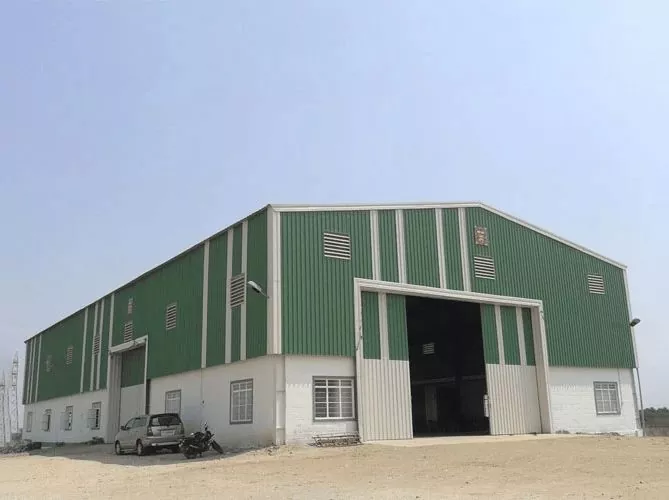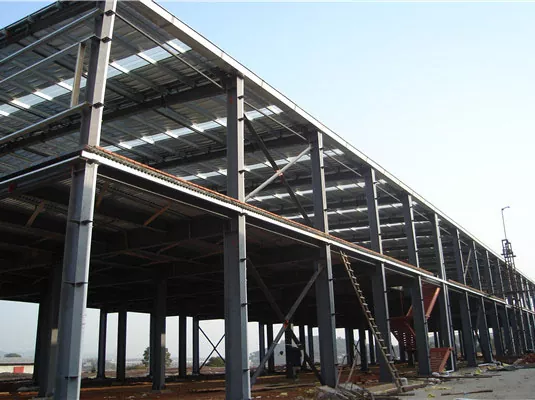QR Code

1. Faster Construction
One of the most significant advantages of prefabricated metal warehouse buildings is the speed of construction. Traditional construction methods can be time-consuming, involving numerous on-site processes. In contrast, prefabricated buildings are manufactured off-site in a controlled environment, allowing for simultaneous site preparation and component fabrication. This parallel processing significantly reduces the overall construction timeline, enabling businesses to start operations sooner and realize a faster return on investment.
2. Cost-Effectiveness
Prefabricated metal buildings are known for their cost-efficiency. The controlled factory environment ensures precise fabrication, minimizing material wastage and labor costs. Additionally, the speed of construction reduces labor expenses and project overheads. The long-term maintenance costs are also lower due to the durability and minimal upkeep requirements of steel structures. This combination of factors makes prefab metal warehouses a financially attractive option for many businesses.
3. Durability and Strength
Steel is renowned for its strength and durability. Prefabricated metal warehouse buildings can withstand harsh weather conditions, heavy loads, and even natural disasters such as earthquakes and hurricanes. The resilience of steel ensures that the warehouse maintains its structural integrity over time, providing a safe and secure environment for storing valuable goods.
4. Flexibility in Design
Prefab metal buildings offer remarkable flexibility in design. Whether it's the size, layout, or specific features, these structures can be customized to meet the unique requirements of different businesses. The modular nature of steel components allows for easy expansion or modification of the warehouse as the needs of the business evolve. This adaptability is particularly valuable in a dynamic business environment where change is the only constant.
5. Environmental Sustainability
Sustainability is a critical consideration in modern construction practices. Prefabricated metal warehouse buildings are environmentally friendly due to their efficient use of materials and the recyclability of steel. The controlled fabrication process minimizes waste, and the ability to dismantle and recycle steel components at the end of the building's lifecycle reduces its environmental impact. Moreover, the energy-efficient design of these warehouses can contribute to lower operational energy consumption.
1. Planning and Design
The construction process begins with a thorough planning and design phase. This involves determining the specific requirements of the warehouse, including size, capacity, layout, and any specialized features. Based on these requirements, a detailed design plan is created, outlining the structure's dimensions, materials, and construction methods. This phase is crucial as it sets the foundation for the entire project.
2. Foundation Preparation
Once the design is finalized, the next step is preparing the foundation. Geological surveys are conducted to assess soil conditions and determine the appropriate foundation type, such as concrete slabs or piles. The foundation is then prepared according to the design specifications, ensuring it can support the weight and loads of the steel structure.
3. Steel Structure Fabrication
The steel components, including beams, columns, braces, and roof trusses, are prefabricated in a factory setting. High-quality steel is used, and the components are manufactured to precise specifications to ensure they fit together accurately and securely during installation. This controlled environment allows for stringent quality control measures, ensuring the durability and reliability of the components.
4. Steel Structure Installation
The prefabricated components are delivered to the construction site and assembled using cranes and other heavy equipment. The installation process typically begins with erecting and anchoring the columns to the foundation. Beams are then installed to connect the columns, forming the frame of the warehouse. Roof trusses are erected and secured to the frame, supporting the roofing system. This systematic approach ensures a sturdy and stable structure.
5. Roofing and Exterior Cladding
Once the steel frame is complete, the roofing system is installed. This typically involves insulated metal panels or single-ply membrane materials, providing both durability and thermal efficiency. Exterior walls, if included in the design, are installed using metal panels, brick, or other cladding materials. This phase enhances the aesthetic appeal of the warehouse while ensuring weather resistance and energy efficiency.
6. Interior Finishes and Systems
The interior of the warehouse is finished according to the specified requirements. This includes installing flooring, lighting, ventilation, and fire protection systems. Storage racks, mezzanines, and other specialized equipment may also be installed to optimize the warehouse's operational efficiency. This phase ensures that the warehouse is fully functional and ready for use.
7. Inspection and Testing
Upon completion, the warehouse undergoes a thorough inspection to ensure it meets all safety and quality standards. Load testing may be performed to verify the structure's ability to support the intended loads. This phase is critical to ensure the safety and reliability of the warehouse before it becomes operational.
8. Commissioning and Handover
Once the warehouse is deemed safe and ready for use, it is commissioned and handed over to the owner or operator. Final documentation, including as-built drawings, warranties, and operating manuals, is provided to facilitate ongoing maintenance and operation. This phase marks the culmination of the construction process, ensuring a smooth transition to operational status.
1. Corrosion Resistance
One of the challenges associated with metal structures is corrosion. To address this, high-quality steel with anti-corrosion treatments is used. Additionally, regular maintenance and protective coatings can prolong the lifespan of the warehouse and prevent corrosion-related issues.
2. Initial Cost
While prefabricated metal buildings are cost-effective in the long run, the initial cost can be higher compared to traditional construction methods. However, the long-term savings in maintenance, operational efficiency, and faster return on investment often offset the initial expenditure.
3. Noise and Thermal Conductivity
Metal buildings can be prone to noise and thermal conductivity issues. Insulated panels and soundproofing materials can mitigate noise, while thermal insulation materials can help maintain a comfortable indoor environment. These solutions enhance the overall functionality and comfort of the warehouse.
4. Fire Resistance
Fire resistance is another concern for metal structures. Implementing fire-resistant materials and systems, such as fireproof coatings and sprinkler systems, can significantly enhance the fire safety of the warehouse. Compliance with fire safety regulations ensures the protection of both the structure and its contents.
5. Environmental Impact
While steel is recyclable, the production process can have a significant environmental impact. Sourcing steel from environmentally responsible manufacturers and implementing sustainable construction practices can mitigate this impact. Additionally, the energy efficiency of the completed warehouse contributes to its overall sustainability.
1. Global Distribution Center
A global distribution company recently constructed a state-of-the-art prefab metal warehouse to streamline its operations. The warehouse features a modular design that allows for easy expansion as the business grows. The use of insulated metal panels ensures energy efficiency, while the prefabricated components reduced construction time by 40%, enabling the company to start operations ahead of schedule.
2. E-Commerce Fulfillment Center
An e-commerce giant opted for a prefab metal warehouse to accommodate its growing inventory and improve order fulfillment speed. The warehouse incorporates advanced storage systems and automated equipment, enhancing operational efficiency. The durability and strength of the steel structure ensure the safety of stored goods, while the flexible design allows for future modifications as business needs evolve.
3. Cold Storage Facility
A food distribution company built a prefabricated metal cold storage facility to maintain the freshness of perishable goods. The warehouse features insulated walls and a specialized refrigeration system to ensure optimal temperature control. The quick construction timeline allowed the company to meet increasing demand during peak seasons, highlighting the practical benefits of prefab metal buildings.
Practical and beautiful prefab metal warehouse building offer a compelling blend of practicality, cost-effectiveness, and aesthetic appeal. Their rapid construction, durability, flexibility, and sustainability make them an ideal choice for businesses seeking efficient and reliable storage solutions. As the demand for warehouse space continues to grow, the adoption of prefabricated metal buildings is likely to increase, driven by their ability to meet the evolving needs of various industries. Whether for logistics, e-commerce, or specialized storage, prefab metal warehouses provide a robust and beautiful solution that stands the test of time.


Address
No. 568, Yanqing First Class Road, Jimo High-tech Zone, Qingdao City, Shandong Province, China
Tel

Copyright © 2024 Qingdao Eihe Steel Structure Group Co., Ltd. All Rights Reserved.
Links | Sitemap | RSS | XML | Privacy Policy |
TradeManager
Skype
VKontakte
